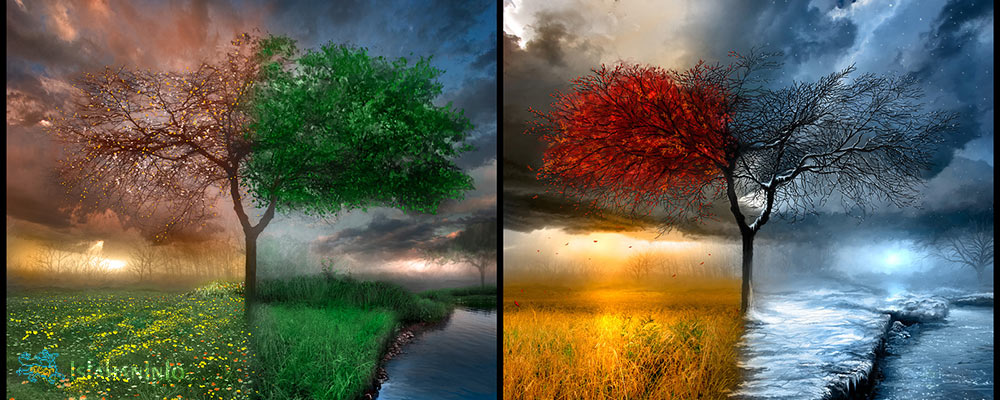Iran Seasons
How the Seasons of Iran Came To Be
Iran, located at the crossroads of four geo-climatic zones, is one of the unique four season countries in the world. From the hot deserts in winter to the mountains where the temperature drops to minus 2°C in summer. In some regions you can experience summer and winter in half a day. Seasons in Iran are described in this post.
Iran Climate and Seasons
Iran seasons weather differs in different parts of the country. The most frequent question are that ‘’is Iran a desert?’’ or ‘’what kind of climate does Iran have?’’ to answer these questions the overall explanation on Iran seasons is needed. Iran seasons weather depends on the geographical feathers of the region. In the north the lands are covered with green forests. Caspian Sea coast has sub-tropical weather with moderate climate. Alborz mountain range, separates the north from the dry center. Heavy rainfalls occur mostly during spring and winter, but it is a fantastic destination in May and September and perfect for: beaches, water sports, views, outdoor activities and adventure.
With hot and humid climate, Iran is led to the Persian Gulf in the south. beautiful Palm trees as a symbol of Southern Iran are lined along the beaches and swaying in the wind on city streets. Best Time to Visit the south of Iran for the beaches is from February to May.
in the east and the center of this vast land Hot deserts with running sand and nights full of stars, are located. Dasht-e Loot, one among many of the deserts, has the hottest ground temperatures on Earth. The best time to visit is in the spring or fall. As it has been explained we can conclude that Iran is not a desert rather it has a number of outstanding and beautiful deserts among it.
In the west of Iran, mostly the northwest, the high mountains with heavy snowfall, have always caused cold and subfreezing temperatures. some Mountains are covered vastly with oat and walnut trees. For mountaineers, the climbing window between April and May is one of the best times.
Iran 4 seasons
In this section, we are going to answer the most frequently asked questions about Iran as a four season country. The questions are as followed below:
- Does Iran have 4 seasons?
- How many seasons does Iran have?
- What season is it in Iran?
As mentioned earlier Iran is a four season country. Iran has four seasons and each season somehow stays for an equal time as other seasons. Iran seasons in different parts of the country may differ in cases of weather and climate. Spring, summer, winter and autumn are Iran 4 seasons. The features of each Iran season and the time of their occurrence in each region of Iran is explained and divided as below.
Iran seasons month
If you have, questions like:
- What is the weather like in Iran in December?
- What is the weather like in Iran in April?
- What is the best time of year to visit Iran?
- When is the best month to visit Iran?
- When is the best time to travel to Iran?
And so on, this month-by-month guide will be a great use to you…
Spring
from April to June
How much does it rain in Iran?
Weather is typically fairly mild and most of the rainfall occurs during the spring and winter. Spring is a fairly short season in Iran and one of the advisable seasons to visit Iran.
Summer
from July to September
How hot is Iran in the summer?
Daily temperatures can be very hot in most regions. high humidity specially on the southern coastal areas of the Persian Gulf. on some days, temperatures can reach easily 40°C or more.
Summer
Fall
from October to December
Is Iran Hot or cold?
Why is Iran so cold?If you are looking to travel to Iran during a season that is neither too cold nor hot this is your chance. the majority of travelers visit Iran in fall season from late September to December. in most of the areas, the weather is neither too cold nor too warm.
Winter
from January to March
Does it snow in Iran?
How cold is Iran in winter?
How cold does it get in Iran?
Does snow fall in Iran?
Does Iran have winter?
Is there winter in Iran?Iran Winter season is Iran ski season as most of the places in the world. There might be some ski resorts open in other seasons too. If you want more information on that, you can ask about it in the comments before planning your trip. Iran’s mountainous regions are the most likely regions for snow. During winter, Iran snow season, the weather in southern regions of Iran is often mild. Sometimes the cold air blowing from Siberia cause mild temperature drops.
Winter
”it is never guaranteed that what happened in the past will happen in the future. But It does gives us a valuable view point.”
Isfahan weather by month
January
Winter in Isfahan is typically cold. If you visit now, you will definitely need to bring winter clothing. On average, however, snowfall does not occur frequently.
February
low temperatures are still quite chilly. You will still need to be prepared for cold days by packing plenty of warm winter clothing.
March
March is one of the high seasons in Isfahan. Just before the beginning of springtime. It is likely to be cold but, there is a noticeable warming. You can feel that the weather is beginning to improve. Bring a mix of clothing, including items for both mild and cold weather.
April
With more sun and longer days, things are starting to warm up a little bit. temperatures are average on the cool side. It is unlikely to be warm but rather more fresh and breezy weather. Expect a mix of sunny and rainy days. April is another high season in Isfahan.
May
It is starting to feel more like spring now, things are noticeably warming now, however, during the first half of the spring it can still get cold.
June
sunny days with the average to high temperatures. You will need mostly lightweight clothing with summer just around the corner.
July
July is one of the warmest months of the year in Isfahan. July marks a big change, with summer officially here, and temperatures have increased significantly.
August
August continues those warm days and summer sunshine.
September
While it is still summer, temperatures begin to gradually cool. While September marks the end of summer and temperatures start to cool, the first half of the month is still quite warm. You are likely to need a few items for cooler days and nights.
October
With the arrival of fall with things cooling down, a chill is likely to be in the air by now. though you’re still likely to enjoy a number of warm and sunny days.
November
Most days are chilly so you will have to be prepared for the cold. Nights are particularly chilly. Days are shorter and there is less sunshine
December
Daytime temperatures typically range between 5°C to 8°C while nighttime lows hover around 3°C. Bring your winter clothing.
The four seasons of the year in the colors of tinted glass windows, as green for spring, red for summer, yellow for fall, and blue for winter
Iran high season
What is the best time to go to Iran?
To answer this question, we have to consider certain possibilities. Do you want to travel during a busy time that most travelers prefer for its weather or other conditions such as holidays or special ceremonies? Or do you want to travel according to your own priorities? The high seasons of Iran can be categorize as below.
- September and October
As explained before, this is the best Iran season to travel. In most of the areas, the weather is neither too cold nor too warm. - April to June
The spring weather is also the best weather for traveling in Iran. Warm weather begins to push in while the cold air still gives out coolness. - March
Like spring, the weather has warmed up a little bit. There is wind and the flowers begin to blossom. However, you might want to consider that from 21th march to 30th it is the national Nowruz holiday. During this time, the locals themselves are traveling and most places might be filled with crowds.






Leave a Reply
Want to join the discussion?Feel free to contribute!